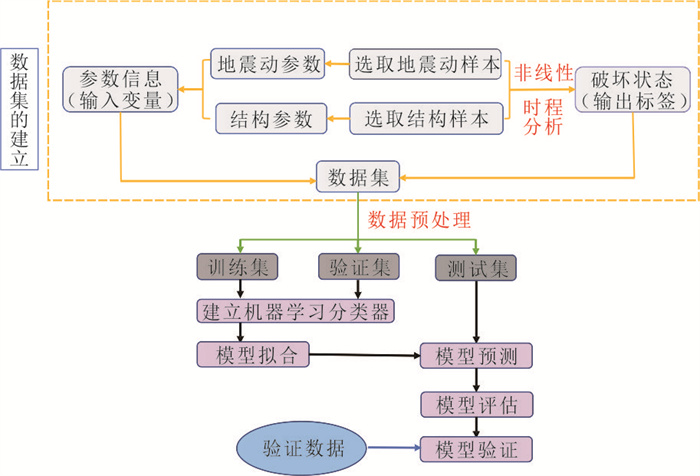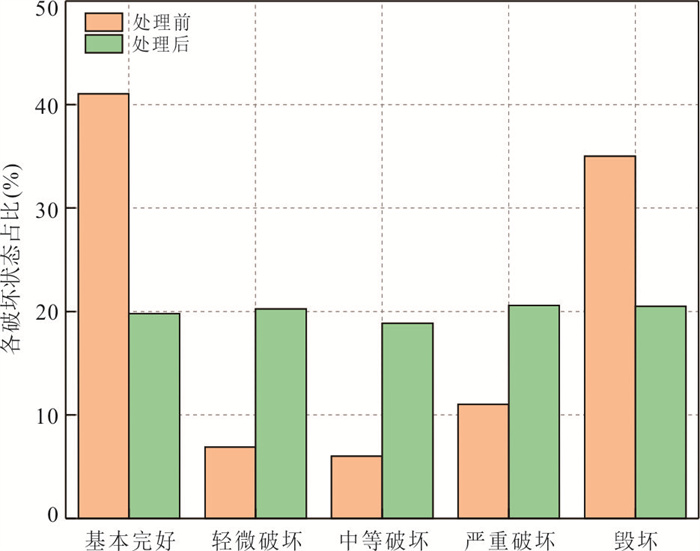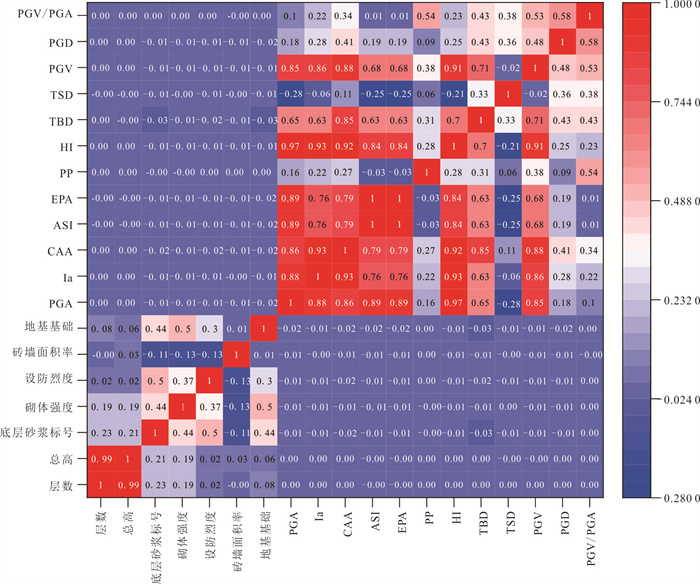A Machine Learning-Based Method for Rapid Prediction of Earthquake Damage in Brick Masonry Houses
-
摘要: 由于现有的震害预测方法不能对砖砌体结构做出高效的预测,基于机器学习模型,提出了一种综合考虑地震动特性与结构特性的砖砌体结构震害快速预测方法.该方法利用机器学习模型,从时域、频域、反应谱和持时4个方面初步选取了能够代表地震动特性的12个参数,从承载力、刚度等方面初步选取了与砖砌体结构破坏相关性较强的7个结构参数;将地震动参数与结构参数相结合作为输入变量,分别给出了基于支持向量机(SVM)、随机森林(RF)、人工神经网络(ANN)三种机器学习模型的砖砌体结构的震害快速预测方法,并进行了性能比较;采用相关性分析对输入参数进行进一步优化,给出了优化输入参数后的最优预测模型.结果表明,当采用19个输入参数时,ANN模型的预测准确率最高,达到91.56%.当采用优化后的12个参数作为输入时,基于RF模型的预测性能更加稳定,预测的准确率也更高,可达到90.01%.优化输入参数后的基于RF模型的预测方法可以实现对砖砌体结构震害的快速预测;与只考虑结构参数或只考虑地震动参数作为输入的方法相比,同时考虑结构和地震动参数作为输入的方法极大地提高了预测的准确性.Abstract: Since the existing earthquake damage prediction methods cannot make rapid predictions for brick masonry structures. A rapid prediction method for earthquake damage of brick masonry structures is proposed. The method uses a machine learning model, considering the ground motion characteristics and structural characteristics. 12 ground motion parameters that represent the ground motion characteristics and 7 structural parameters that have a strong correlation with the damage of brick masonry structures are selected. The ground motion parameters are considered in four aspects: time domain, frequency domain, response spectrum and holding time, and the structural parameters are considered in terms of bearing capacity and stiffness. Three machine learning models based on support vector machine, random forest and artificial neural network are given for fast prediction of seismic damage of brick masonry structures. The input parameters were further optimized using correlation analysis, and the optimal model after optimizing the input parameters was given. The results show that the ANN model has the highest prediction accuracy of 91.56% when 19 input parameters were used. The prediction accuracy of the RF model-based earthquake damage prediction method was higher when 12 optimized parameters were used as inputs, reaching 90.01%. The prediction performance of the RF-based model was more stable when the input parameters were gradually reduced. The optimized input parameters of the RF model-based prediction method can achieve rapid prediction of seismic damage to brick masonry structures. The method that considers both structural and ground vibration parameters as input greatly improves the accuracy of prediction compared to the method that considers only structural parameters or only ground vibration parameters as input.
-
表 1 地震动参数及对应的计算方法
Table 1. Ground motion parameters and the corresponding calculation methods
参数名称 简称 计算方法 分类 地面峰值加速度 PGA $ \mathrm{m}\mathrm{a}\mathrm{x}\left|a\left(t\right)\right| $ 时域参数 地面峰值速度 PGV $ \mathrm{m}\mathrm{a}\mathrm{x}\left|v\right(t\left)\right| $ 地面峰值位移 PGD $ \mathrm{m}\mathrm{a}\mathrm{x}\left|d\right(t\left)\right| $ Arias强度 Ia $ \frac{\mathrm{\pi }}{2g}{\int }_{{t}_{1}}^{{t}_{2}}[a{\left(t\right)]}^{2}\mathrm{d}t $ 累计绝对加速度 CAA $ {\int }_{{t}_{1}}^{{t}_{2}}\left|a\left(t\right)\right|\mathrm{d}t $ 有效峰值加速度 EPA $ \frac{1}{2.5}\{{\stackrel{-}{S}}_{a}{(\xi =0.05,T\}}_{0.1}^{0.5} $ 反应谱参数 加速度谱强度 ASI $ {\int }_{0.1}^{0.5}{S}_{a}(\xi =0.05,T)\mathrm{d}T $ Housner强度 HI $ {\int }_{0.1}^{2.5}\mathrm{P}\mathrm{S}\mathrm{V}(\xi =0.05,T)\mathrm{d}T $ 括号持时 TBD 第一次和最后一次超过0.025 g的时间 持时参数 显著持时/能量持时 TSD $ 5\mathrm{\%}\le {\int }_{0}^{t}a{\left(t\right)}^{2}\mathrm{d}t/{\int }_{0}^{T}a{\left(t\right)}^{2}\mathrm{d}t\le 95\mathrm{\%} $ Vmax/Amax PGV/PGA $ \mathrm{m}\mathrm{a}\mathrm{x}\left|v\left(t\right)\right|/\mathrm{m}\mathrm{a}\mathrm{x}\left|a\left(t\right)\right| $ 频域参数 卓越周期 PP $ T\left[\mathrm{m}\mathrm{a}\mathrm{x}{S}_{a}(\xi =0.05,T)\right] $ 注:a(t)、v(t)、d(t)分别表示加速度、速度和位移时程;Sa表示加速度反应谱;ξ表示阻尼比;t1,t2分别对应于Arias强度的5%和95%. 表 2 所选砖砌体结构样本的信息
Table 2. The information of selected brick masonry structure samples
结构特性 取值范围 总高 6~16.4 m 砖强度 MU7.5、MU10 底层砂浆强度 M2.5、M5、M7.5、M10 砖墙面积率 8%~15% 层数 2~6层 地基基础 条形基础、砖基础 设防烈度 6~7度 表 3 最优机器学习模型的主要超参数数值
Table 3. Main hyperparameter values of the optimal machine learning model
机器学习算法 主要超参数的数值 SVM C=2,gamma=0.1,kernel=rbf RF n_estimators = 16 ANN hidden_layer_sizes=(100、100、80、80、60、50、30、20);activation=tanh;slover=adam;learning_rate= constant;max_iter=200 表 4 基于SVM模型的精确率和召回率
Table 4. Precision and recall of SVM-based method
基本完好 轻微破坏 中等破坏 严重破坏 毁坏 召回率(%) 基本完好 292 17 6 2 0 92.11 轻微破坏 17 316 15 1 0 90.54 中等破坏 13 10 346 9 3 90.81 严重破坏 7 4 14 320 6 91.17 毁坏 0 2 4 19 319 92.70 精确率(%) 88.75 90.54 89.87 91.17 97.26 91.4791.52 表 5 基于RF模型的精确率和召回率
Table 5. Precision and recall of RF-based method
基本完好 轻微破坏 中等破坏 严重破坏 毁坏 召回率(%) 基本完好 299 18 4 1 0 92.86 轻微破坏 6 333 21 9 2 89.76 中等破坏 5 18 338 18 2 88.71 严重破坏 2 6 21 305 11 88.40 毁坏 0 2 4 19 298 92.26 精确率(%) 95.83 88.33 87.11 86.65 95.24 90.4090.63 表 6 基于ANN模型的精确率和召回率
Table 6. Precision and recall of ANN-based method
基本完好 轻微破坏 中等破坏 严重破坏 毁坏 召回率(%) 基本完好 317 13 1 0 0 95.77 轻微破坏 12 330 15 5 0 91.16 中等破坏 3 15 349 19 2 89.55 严重破坏 0 0 12 325 18 91.55 毁坏 0 1 3 28 274 89.54 精确率(%) 95.48 91.92 91.84 86.21 93.20 91.5991.73 表 7 三种模型的F1分数与预测时间
Table 7. F1 scores and prediction speed of the three methods
机器学习算法 F1分数(%) 预测时间(s) SVM 91.49 0.000 20 RF 90.51 0.000 20 ANN 91.64 0.000 36 表 8 具有不同输入变量方法的准确率
Table 8. Accuracy of methods with different input variables
结构参数(%) 地震动参数(%) 结构+地震动(%) SVM 53.53 63.13 91.45 RF 55.28 62.89 90.30 ANN 61.34 60.32 91.56 表 9 输入参数数量与每个模型对应的准确率
Table 9. The number of input parameters and the corresponding accuracy of each model
输入参数数量 19 18 17 16 15 14 13 12 SVM(%) 91.45 90.99 90.59 90.01 89.78 89.38 89.04 88.64 RF(%) 90.30 90.47 90.11 90.24 90.36 90.59 90.41 90.01 ANN(%) 91.56 90.70 90.37 90.30 90.07 89.84 89.27 87.09 表 10 新测试集的混淆矩阵
Table 10. Confusion matrix for the new test set
基本完好 轻微破坏 中等破坏 严重破坏 毁坏 基本完好 46 0 0 0 0 轻微破坏 2 7 4 0 0 中等破坏 0 1 8 1 0 严重破坏 0 0 6 5 5 毁坏 0 0 4 1 30 表 11 试验与数值模拟样本的混淆矩阵
Table 11. Confusion matrix of experimental and numerical simulation samples
基本完好 轻微破坏 中等破坏 严重破坏 毁坏 基本完好 10 0 0 0 0 轻微破坏 0 1 0 0 0 中等破坏 0 0 1 1 0 严重破坏 0 0 0 1 4 毁坏 0 0 0 0 3 -
Breiman, L., 1996. Bagging Predictors. Mach Learn, 24(2): 123-140. Chen, J. Y., Li, J., Han, J. C., et al., 2017. Correlation between Ground Motion Intensity Indexes and Seismic Responses of Frame Structures. Journal of Vibration and Shock, 36(3): 105-112, 144 (in Chinese with English abstract). http://en.cnki.com.cn/Article_en/CJFDTOTAL-ZDCJ201703017.htm Gunn, S. R., 1998. Support Vector Machines for Classification and Regression. ISIS Technical Report, 14(1): 5-16. http://pubs.rsc.org/en/content/articlelanding/2010/jm/b918972f Harirchian, E., Kumari, V., Jadhav, K., et al., 2020. A Machine Learning Framework for Assessing Seismic Hazard Safety of Reinforced Concrete Buildings. Applied Sciences, 10(20): 7153. https://doi.org/10.3390/app10207153 Ho, T. K., 1998. The Random Subspace Method for Constructing Decision Forests. IEEE Transactions on Pattern Analysis and Machine Intelligence, 20(8): 832-844. https://doi.org/10.1109/340709601 Lautour, O. R., Omenzetter, P., 2009. Prediction of Seismic-Induced Structural Damage Using Artificial Neural Networks. Engineering Structures, 31(2): 600-606. https://doi.org/10.1016/j.engstruct.2008.11.010 Liu, B. Y., Ye, L. Y., Jiang, J. J., 2002. Forecasting Seismic Damage in Multistory Masonry Buildings with a Neuro-Fuzzy Approach. Journal of Tsinghua University (Science and Technology), 42(6): 843-846 (in Chinese with English abstract). http://en.cnki.com.cn/article_en/cjfdtotal-qhxb200206035.htm Luo, Z. T., 2018. Study on Seismic Performance of Masonry Structure with Falling Floors Based on Dynamic Elastic-Plastic Analysis (Dissertation). Southwest Jiaotong University, Chengdu (in Chinese with English abstract). Mangalathu, S., Sun, H., Nweke, C. C., et al., 2020. Classifying Earthquake Damage to Buildings Using Machine Learning. Earthquake Spectra, 36(1): 183-208. https://doi.org/10.1177/8755293019878137 Morfidis, K., Kostinakis, K., 2017. Seismic Parameters' Combinations for the Optimum Prediction of the Damage State of R/C Buildings Using Neural Networks. Advances in Engineering Software, 106: 1-16. https://doi.org/10.1016/j.advengsoft.2017.01.001 Morfidis, K., Kostinakis, K., 2018. Approaches to the Rapid Seismic Damage Prediction of R/C Buildings Using Artificial Neural Networks. Engineering Structures, 165: 120-141. https://doi.org/10.1016/j.engstruct.2018.03.028 Pan, Z. H., Hong, B., 2014. Influence of Spectral Characteristics and Duration of Ground Motions on Results of IDA. Journal of Vibration and Shock, 33(5): 155-159, 199 (in Chinese with English abstract). http://www.researchgate.net/publication/290098885_Influence_of_spectral_characteristics_and_duration_of_ground_motions_on_results_of_IDA Shaheen, M. S. A., Hakan, G., 2022. Robust Multi-Output Machine Learning Regression for Seismic Hazard Model Using Peak Crust Acceleration Case Study, Turkey, Iraq and Iran. Journal of Earth Science, 1-54. https://doi.org/10.1007/s12583-022-1616-2 Tang, H., Chen, G. X., Li, F. M., 2006. Seismic Damage Prediction of Multistory Masonry Buildings Based on BP Neural Network Model. Earthquake Engineering and Engineering Vibration, 26(4): 141-146 (in Chinese with English abstract). http://epub.cnki.net/grid2008/docdown/docdownload.aspx?filename=DGGC200604023&dbcode=CJFD&year=2006&dflag=pdfdown Wang, X., Sun, B. T., Yan, P. L., et al., 2019. Influence Analysis of Constructional Column and Masonry Mortar on Seismic Resistance of Masonry Structure. Earthquake Prevention Technology, 14(3) : 501-512 (in Chinese with English abstract). Wu, B., Qiu, W. X., Xu, S. X., et al., 2022. A Method for Assessing the Probability of Tunnel Collapse Based on Artificial Intelligence Deformation Prediction. Earth Science, 1-16 (in Chinese with English abstract). doi: 10.1007/s13369-021-06359-z?utm_content=meta Xu, Y. J., Lu, X. Z., Tian, Y., et al., 2020. Real-Time Seismic Damage Prediction and Comparison of Various Ground Motion Intensity Measures Based on Machine Learning. Journal of Earthquake Engineering, 1-21. https://doi.org/10.1080/13632469.2020.1826371 Yang, T. F., 2018. Research on the Influence Factors of Seismic Performance of Masonry Structures Based on Numerical Simulation (Dissertation). Xi'an University of Architecture and Technology, Xi'an (in Chinese with English abstract). Zhang, G. X., Sun, B. T., 2010. A Method for Earthquake Damage Prediction of Building Groups Based on Multiple Factors. World Earthquake Engineering, 26(1): 26-30 (in Chinese with English abstract). http://www.researchgate.net/publication/294627853_A_method_for_earthquake_damage_prediction_of_building_groups_based_on_multiple_factors Zhang, L. X., Dai, J. H., Shen, J. K., et al., 2019. Rapid Prediction Model of Earthquake Damage to Frame Structure Based on LM-BP Neural Network. Journal of Natural Disasters, 28(2): 1-9 (in Chinese with English abstract). http://en.cnki.com.cn/Article_en/CJFDTotal-ZRZH201902001.htm Zhang, L. X., Jiang, J. R., Liu, J. P., 2002. Seismic Vulnerability Analysis of Multistory Dwelling Brick Buildings. Earthquake Engineering and Engineering Vibration, 22(1): 49-55 (in Chinese with English abstract) http://en.cnki.com.cn/Article_en/ http://search.cnki.net/down/default.aspx?filename=DGGC200201009&dbcode=CJFD&year=2002&dflag=pdfdown Zhang, L. X., Kong, J. H., 2021. Comparative Analysis for Seismic Performance of Masonry Structure with Bottom Frame Designed with New and Old Codes. Journal of Shenyang University of Technology, 43(2): 220-227 (in Chinese with English abstract). Zhang, L. X., Lu, R. F., Zhu, B. J., 2021. Determination and Verification for the Nonlinear Seismic Response Analysis Method and the Damage State Index of Brick Masonry Buildings. Earthquake Engineering and Engineering Vibration, 41(3): 1-10 (in Chinese with English abstract). Zhang, Z. Q., Fan, J. Q., Zeng, P., et al., 2023. Probabilistic Classification Prediction of Tunnel Squeezing Based on Bayesian Network and Its Application during the Investigation and Design Stage. Earth Science, 48(5): 1923-1934 (in Chinese with English abstract). 陈健云, 李静, 韩进财, 等, 2017. 地震动强度指标与框架结构响应的相关性研究. 振动与冲击, 36(3): 105-112, 144. https://www.cnki.com.cn/Article/CJFDTOTAL-ZDCJ201703017.htm 刘本玉, 叶燎原, 江见鲸, 2002. 用模糊人工神经网络方法预测多层砖房震害. 清华大学学报(自然科学版), 42(6): 843-846. https://www.cnki.com.cn/Article/CJFDTOTAL-QHXB200206035.htm 罗梓桐, 2018. 基于动力弹塑性分析的掉层砌体结构抗震性能研究(硕士学位论文). 成都: 西南交通大学. 潘志宏, 洪博, 2014. 地震动频谱特性和持时对IDA结果影响的研究. 振动与冲击, 33(5): 155-159, 199. https://www.cnki.com.cn/Article/CJFDTOTAL-ZDCJ201405029.htm 汤皓, 陈国兴, 李方明, 2006. 基于BP神经网络模型的多层砖房震害预测方法. 地震工程与工程振动, 26(4): 141-146. https://www.cnki.com.cn/Article/CJFDTOTAL-DGGC200604023.htm 王晓, 孙柏涛, 闫培雷, 等, 2019. 构造柱和砌筑砂浆对砌体结构抗震能力影响分析. 震灾防御技术, 14(3): 501-512. https://www.cnki.com.cn/Article/CJFDTOTAL-ZZFY201903004.htm 吴波, 邱伟兴, 徐世祥, 等, 2022. 基于人工智能变形预测隧道坍塌失效概率评估方法. 地球科学, 1-16. 杨腾飞, 2018. 基于数值模拟的砌体结构抗震性能影响因素研究(硕士学位论文). 西安: 西安建筑科技大学. 张桂欣, 孙柏涛, 2010. 多因素影响的建筑物群体震害预测方法研究. 世界地震工程, 26(1): 26-30. https://www.cnki.com.cn/Article/CJFDTOTAL-SJDC201001005.htm 张令心, 戴静涵, 沈俊凯, 等, 2019. 基于LM-BP神经网络的钢筋混凝土框架结构震害快速预测模型. 自然灾害学报, 28(2): 1-9. https://www.cnki.com.cn/Article/CJFDTOTAL-ZRZH201902001.htm 张令心, 江近仁, 刘洁平, 2002. 多层住宅砖房的地震易损性分析. 地震工程与工程振动, 22(1): 49-55. https://www.cnki.com.cn/Article/CJFDTOTAL-DGGC200201009.htm 张令心, 孔建辉, 2021. 新旧规范设计的底框砌体结构抗震性能对比分析. 沈阳工业大学学报, 43(2): 220-227. https://www.cnki.com.cn/Article/CJFDTOTAL-SYGY202102018.htm 张令心, 鲁若帆, 朱柏洁, 2021. 砖砌体房屋非线性地震反应分析方法和破坏状态指标的确定与验证. 地震工程与工程振动, 41(3): 1-10. https://www.cnki.com.cn/Article/CJFDTOTAL-DGGC202103001.htm 张志强, 范俊奇, 曾鹏, 等, 2023. 基于贝叶斯网络的隧道勘察设计期大变形灾害概率分级预测与应用研究. 地球科学, 48(5): 1923-1934. https://www.cnki.com.cn/Article/CJFDTOTAL-DQKX202305017.htm -










 下载:
下载:




